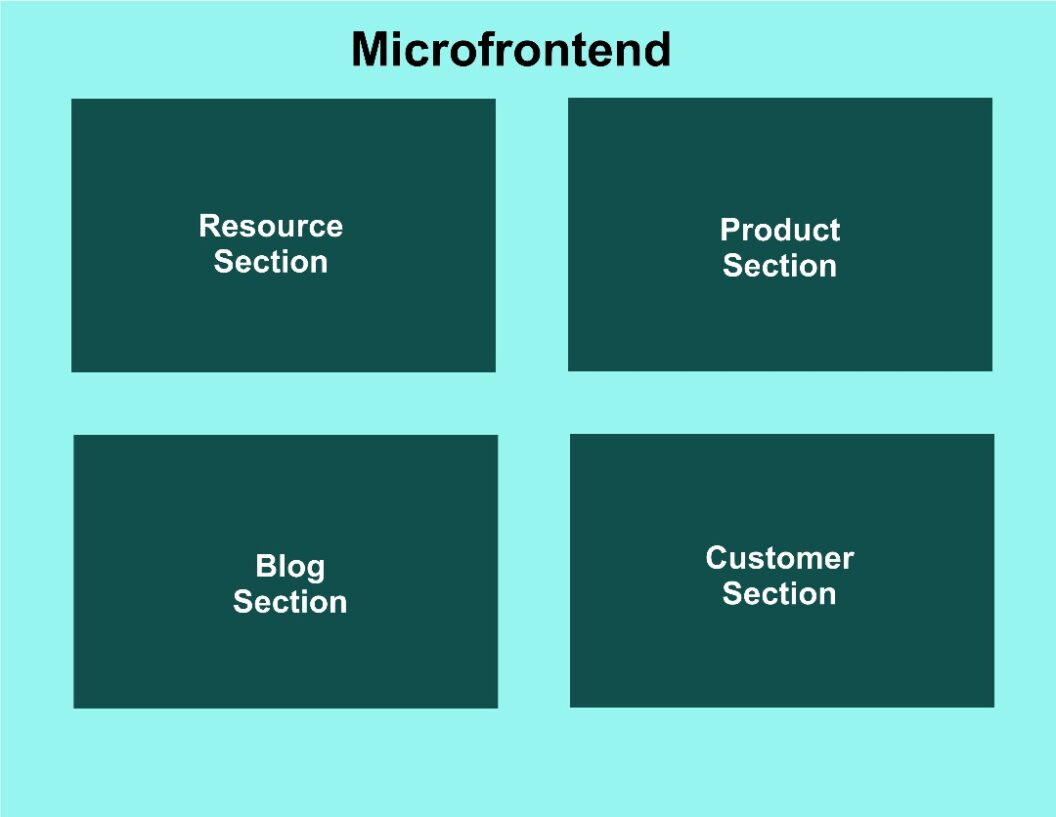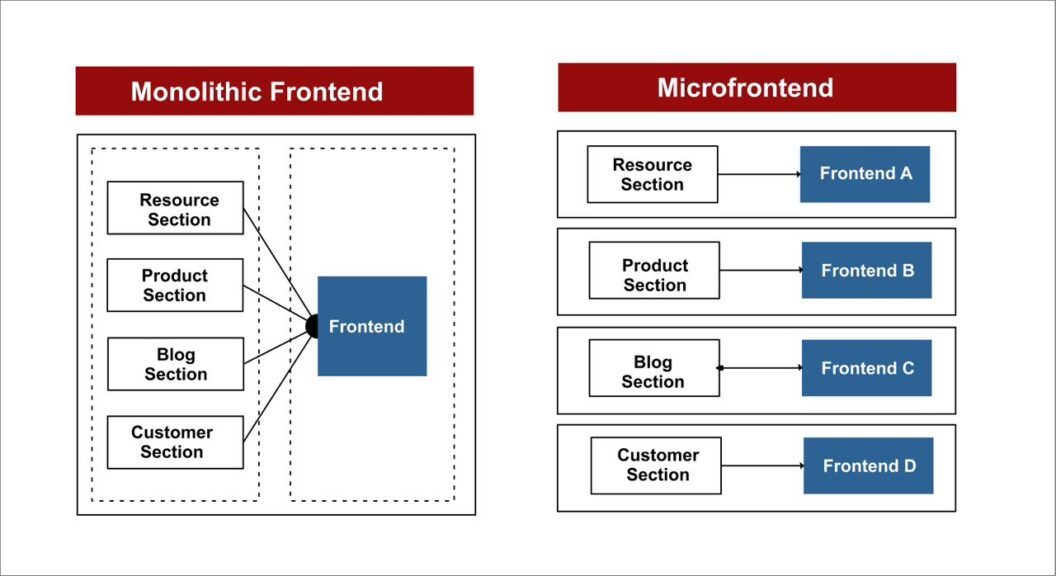Microfrontends have revolutionized modern web development, offering enhanced flexibility, scalability, and user experience. Despite these advantages, misconceptions surrounding microfrontends have proliferated. This article will delve into some myths about microfrontends.
What is a Microfrontend?
Microfrontends are similar to the microservices concept, except they are used in the frontend layer of web applications. Microfrontends, like microservices, deconstruct backend functionality into smaller, independent services. It is an architectural and organizational paradigm in which an application’s user interface is divided into smaller, more manageable components known as “micro apps.”

Consider Semaphore as an example; separate teams might have developed the homepage, blog post, and resource sections. These teams operate in diverse ways to create Semaphore’s website. This modular architecture empowers specialized teams to concentrate on specific features, fostering a cohesive user experience.
Debunking Microfrontend Misconceptions
Having established the concept of microfrontends, let’s debunk some common misconceptions.
1. Microfrontends are Only for Large Applications
Misconceptions, more often than not, cast a shadow over intriguing concepts, and microfrontends are no exception. One common misconception is that microfrontends are only suitable for large-scale applications. Yes, microfrontend excels in complex, enterprise-level projects, but smaller applications can benefit from microfrontends.
Let’s consider a boutique e-commerce store seeking to enhance its online presence. Microfrontends offer a precise solution, allowing the development team to separate the frontend into distinct microfrontends, each catering to a specific aspect of the website. Dividing these functionalities enables parallel development, accelerating the process and delivering a seamless user experience. This approach maximizes productivity for smaller teams with limited resources without overwhelming the development process. Micehal Geers shows a great example of how an e-commerce application can benefit from microfrontends in this code repository.
2. Microfrontends are Equal to Module Federation
Microfrontend and module federation are two separate things entirely. Module federation is a code transport layer that gets code from one application to another as a run time dependency.it is a feature of Webpack 5 that allows a JavaScript application to dynamically run code from another bundle/build on both client and server. Microfrontend is an architectural pattern that breaks down a large web application into smaller, independent components. Different teams can develop and maintain these components, which can be deployed and updated independently.
We can use module federation to build microfrontends, but iframes or Web Components work as well!
The synthesis of microfrontends and module federation can yield powerful results. For instance, an e-commerce platform employing microfrontends for different product categories can benefit from module federation by efficiently integrating shared components like payment processing. This ensures consistency while allowing individual microfrontends to maintain their autonomy. Understanding the unique strengths of these concepts empowers developers to harness their combined potential, creating modern web applications that are responsive, maintainable, dynamic, and adaptable.
3. Microfrontends are More Complex than Other Architectures
The perceived complexity of microfrontends is another common misconception. While microfrontends introduce new challenges, such as inter-module communication, a closer examination reveals that these complexities can be managed and offset by strategic planning and meticulous implementation. Microfrontends can offer a refreshing simplification of development, allowing teams to concentrate on specific features and alleviating the cognitive load associated with large monolithic codebases.

One perceived complexity of microfrontends arises from managing communication between modules. Consider an online marketplace embracing microfrontends to handle various functions like product search, reviews, and checkout. Effective communication between these modules is crucial for a seamless user experience. However, we can mitigate this challenge by adopting well-established patterns like event-driven architecture. Each module can publish and subscribe to events, enabling real-time updates and interactions without tightly coupling the components. While this communication layer adds additional consideration, it fosters modularity and flexibility, allowing modules to evolve independently.
4. Microfrontends are Not Secure
Security is a paramount concern in web development, and some sceptics argue that microfrontends introduce vulnerabilities due to their distributed nature. While this scepticism is not entirely unfounded, it’s important to recognize that microfrontends can enhance web applications’ security posture when approached with a security-first mindset. The key lies in carefully implementing security measures and strategically utilizing microfrontends’ modular architecture.
Consider a financial management application that embraces microfrontends to handle diverse functionalities, such as account balances, transaction history, and budget planning. The decentralized nature of microfrontends might lead to apprehensions about data breaches or unauthorized access. However, we can mitigate this risk through rigorous security practices. Independent deployment of microfrontends empowers development teams to address security vulnerabilities swiftly. For instance, if a critical security flaw is discovered in the budget planning microfrontend, the team responsible can deploy a targeted update without affecting other application parts. This agility in addressing security concerns contributes to a more robust and resilient application.
5. Microfrontends are Not Scalable
Mircrofrontends regarded as not being scalable, is one misconception that needs to be disregarded. Microfrontends can be just as scalable as monolithic frontends. Microfrontends are designed to ensure efficient scalability, leveraging their modular architecture to empower applications to handle varying demand levels seamlessly.
Examples of large scalable microfrontend applications include Netflix, Linkedin, and Spotify.
6. Microfrontends is a new technology
Microfrontends are not a new technology. They have been around for several years and are based on the microservices architectural pattern. Microservices is a software development technique that structures an application as a collection of loosely coupled services. Each service is self-contained and performs a specific function, making it easier to develop, test, and deploy applications.
The main difference between microservices and microfrontends is that microservices are used to structure backend applications, while we use microfrontends to structure frontend applications. However, they share many principles, such as loose coupling, independent deployment, scalability, and maintainability.
7. Microfrontends Hinder User Experience Consistency
As developers and engineers, we should dismiss the myth that microfrontend hinders user experience consistency because it is untrue. Microfrontends can improve user experience consistency by allowing teams to focus on developing and maintaining small, self-contained frontends responsible for a specific part of the user experience. This helps ensure the user experience is consistent across all application parts, even if different teams develop them.
Microfrontend can help improve user experience in consistency in many ways, such as implementation in a single codebase, shared components, and centralized design.
Imagine a large e-commerce website with a home page, product listing pages, a checkout page, and a customer care page. Each of these pages might function as its microfrontend, allowing each team to concentrate on building and managing a single page while guaranteeing a uniform user experience across all pages.
Conclusion
The realm of microfrontends is not excluded from misconceptions, but debunking these myths can shed light on the true potential of this architectural pattern. Microfrontends offer enhanced flexibility, improved scalability, and streamlined development processes. By understanding the core principles and dispelling the misconceptions surrounding microfrontends, developers can harness this innovative approach to build modern, responsive, and maintainable web applications. As the web development landscape continues to evolve, embracing microfrontends with accurate knowledge will empower teams to make informed decisions and create exceptional user experiences.
